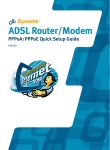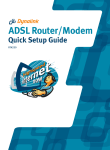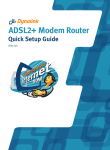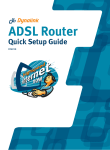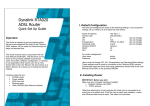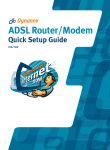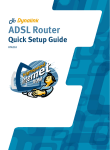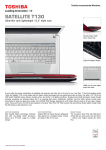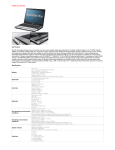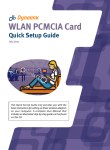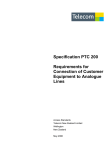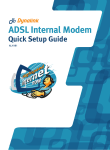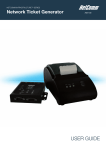Download ADSL Router/Modem
Transcript
ADSL Router/Modem Bridged/Routed Quick Setup Guide RTA230 Important This Guide is intended to get you started quickly. We have made the factory default setting of this router suitable for Australia. All you need is to follow through the steps we describe here. This Guide should be read in conjunction with the RTA23x Series ADSL Router User’s Manual. It is provided as a PDF file on this CD. To view or print the User’s Manual, go to the previous menu ADSL Router (RTA230) and click the View User Manual button. Important safety notes can be found on page III of the User’s Manual. Advanced users or users who have other setup preferences should also read the User’s Manual. If you choose to connect via the Ethernet port, no driver is required. If you choose to connect via the USB port, you will need to load a driver. A driver is only available for Windows 98, ME, 2000 and XP systems. The drivers are found on this CD. To install a driver into Windows, go to the previous menu ADSL Router (RTA230) and click the Modem drivers button. ADSL Router Quick Set-up Guide 1 Default Configuration This Router is shipped with the following factory default settings. Router IP address Subnet mask VPI VCI Connect mode NAT DSL line mode WAN IP DHCP DNS relay UPnP IGD Firewall incoming Firewall outgoing 192.168.1.1 255.255.255.0 8 35 PPPoA VC-MUX enabled auto select G.DMT / T1.413 dynamic enabled on enabled on off Router configuration & management: User name admin Password admin Telnet password admin 2 Before you start Make sure your computer has these installed: Ethernet or USB port TCP/IP protocol enabled A web browser, Internet Explorer 5.0/Netscape 6 or better. Obtain your Internet account information from your ISP: Login user name and password Public IP address (only if you subscribe for static IP) DNS server IP (only if specified by ISP). Choose from your connection options: 1. Ethernet (for standalone computer, Operating System independent) Connect the LAN port of the router directly to the Ethernet port of your computer. One Ethernet cable is provided. 2. Ethernet (for multiple computers, Operating System independent) This is for sharing Internet access. You will need to purchase a network hub and extra Ethernet cables. Using the provided Ethernet cable, connect the LAN port of the router to any of the ports available on the hub. Next, connect each of the computers to the network hub. 3. USB (for standalone Windows 98/ME/2000/XP computers only) Connect via Ethernet is the preferred option. If your computer does not have an Ethernet port you may choose this option. You must then install a driver to operate the router. The drivers are found on this CD. To install a driver into Windows, go to the previous menu and click the Modem drivers button. 3 Connect the Router 1. Connect the DSL port of the router directly into your ADSL jackpoint (telephone wall socket) with the provided line cord. Do not connect through a filter, unless the filter has a designated MODEM port for this purpose. 2. Connect the LAN port of the router and the Ethernet port of your computer using the Ethernet cable provided. If you choose to connect via the USB port, there is no need to use the Ethernet cable. Make no USB connection now. During driver installation, you will be advised to connect the USB port of the router to your computer. 3. Connect the provided AC/AC power adaptor to the PWR jack of the router. Plug the adaptor into a mains power outlet. Switch on the router. The DIAG light will remain on for a short time indicating self-check in progress. Wait until the DIAG light has turned off before proceeding to the next section. In normal operation these three lights shall be on: PWR, LAN (or USB) and DSL. Section 8 of this Guide explains how these indicator lights work. 4 Get your computer ready for networking The description below assumes you are connecting the router via Ethernet. If you are connecting the router via USB, refer to Chapter 2 - USB Driver Installation on page 4 of the User’s Manual on this CD. You have two options. Following option 1 is the simplest. This is the Windows default network setting. ADSL Router Quick Set-up Guide OPTION 1 CONFIGURE YOUR COMPUTER TO OBTAIN AN IP ADDRESS FROM DHCP If your computer is already configured to obtain an IP address automatically (from a DHCP server), do nothing and proceed to Section 5 – Getting On-Line. By default the router is a DHCP server. Windows 95/98/ME: From Control Panel, double click Network. Scroll down and highlight TCP/IP -> (your network card). Click Properties. 1. Select the IP Address tab. Select “Obtain an IP address automatically” 2. Click OK & then OK to finish. You may be prompted for the Windows CD and then be asked to restart. Answer Yes to restart the computer. For Windows 2000/XP: 1. From Control Panel double click Network Connections. Open Local Area Connections and click Properties. Double click Internet Protocol (TCP/IP). Select Obtain an IP address automatically and select Obtain DNS server address automatically. 2. Click OK to finish. You have now finished configuring your computer. Now proceed to Section 5 – Getting On-Line. OPTION 2 MANUALLY ASSIGN AN IP ADDRESS TO YOUR COMPUTER The router’s default address is 192.168.1.1. If you prefer to assign an IP address manually, use 192.168.1.x (x is a number between 2 and 254). Windows XP/2000: 1. Go to Control Panel – Network Connections. Open Local Area Connections and click Properties. Double click Internet Protocol (TCP/IP). Select Use the following IP address. 2. Enter 192.168.1.x (x is a number you pick between 2 and 254). This is the IP address you assign to the computer. Subnet Mask is 255.255.255.0. 3. Enter the router’s IP 192.168.1.1 as Default gateway, and as Preferred DNS server If your ISP specifies DNS server addresses, enter the specified addresses according to the ISP’s instructions. 4. Click OK to finish. You have now finished with configuring your computer. Now proceed to Section 5 – Getting On-Line. Windows 98/ME: 1. From Control Panel, double click Network. Scroll down to highlight TCP/IP > (your network card). Click Properties. 2. Select the IP Address tab. Specify 192.168.1.x (x is a number you pick between 2 and 254). This is the IP address you assign to the computer. Subnet Mask is 255.255.255.0. 3. Select Gateway tab. Enter the router’s IP address 192.168.1.1. Click Add. ADSL Router Quick Set-up Guide 4. Select DNS Configuration tab. Select Enable DNS. If your ISP specifies DNS server addresses, please enter your ISP DNS server address then click Add otherwise enter DNS IP address 192.168.1.1. 5. Click OK & then OK to finish. The system may ask to read the Windows CD, and then ask to restart the computer. You have now finished with configuring your computer. Now proceed to Section 5 – Getting On-line. 5 Getting On-line It takes only 2 easy steps. STEP 1 GO TO THE ‘CONNECT TO INTERNET’ PAGE Start your web browser. Enter the default address http://192.168.1.1. Type admin for both User name and Password. See Q1 in Section 9 - Troubleshooting if you cannot get this screen. Next you will be in the Quick Start > Connect to Internet page. Please make sure you have your ADSL connection details ready. Check with your ISP if you are unsure of the type of service you have subscribed to. STEP 2 ROUTED(IPOA)/MAC ENCAPSULATION ROUTING(MER)/BRIDGED CONFIGURATION Please click “Quick Setup” on the left hand menu. Untick “Auto Scan Internet Connection (PVC)” then click “Next” Please select your ADSL ISP connection type. If your ADSL service is a Routed (IPoA) service, please select “IP over ATM (IPoA)” and go to the Sub Section 1 – IP Over ATM (IPOA). If your ADSL service is a Bridged mode service and you want to share the connection to multiple PC’s, please select “MAC Encapsulation Routing (MER)” and go to Sub Section 2 – MAC Encapsulated Routing (MER), otherwise please select “Bridging” for use on a single PC or if it is connecting behind another router, go to Sub Section 3 - Bridging. Note: if you manually assigned a fixed IP to your computer, or you have another DHCP server already on your LAN, disable the DHCP server on your ADSL router. Refer to Chapter 4 – LAN-DHCP Server on Page 38 of the User Manual. ADSL Router Quick Set-up Guide Sub Section 1 IP Over ATM (IPOA) Select “IP over ATM (IPoA)” then click “Next” Enter your customer public IP address into “WAN IP Address”, enter your customer public IP address subnet mask into “WAN Subnet Mask”, and enter your DNS server address. Make sure Enable NAT is ticked. Click “Next” Check the details and Click “Finish” to accept the settings. It will restart automatically, please wait for 2 minutes. Sub Section 2 MAC Encapsulated Routing (MER) Select “Mac Encapsulation Routing (MER)” then click “Next” Enter your customer public IP address into “WAN IP Address”, enter your customer public IP address subnet mask into “WAN Subnet Mask”, enter your customer default gateway and enter your DNS server address. Make sure Enable NAT is ticked. Click “Next” Check the details and Click “Finish” to accept the settings. It will restart automatically, please wait for 2 minutes. ADSL Router Quick Set-up Guide Sub Section 3 Bridging Please select “Bridging” then click “Next” Click “Next” Check the details and Click “Finish” to accept the settings. It will restart automatically, please wait for 2 minutes. 6 Some advanced functions of your router Firewall & traffic restrictions By default a preset firewall is invoked to block incoming requests including a Ping from the Internet to your private network. In the reverse direction, requests sent from your network can freely pass through to the Internet. If you have local servers on your network and want the servers accessible to Internet users, set up Virtual Servers. Refer to Chapter 4 – NAT Virtual Servers on page 43 of the User’s Manual. If you run applications that require unrestricted 2-way traffic between a computer on your network and the Internet, set up the computer as DMZ Host. Refer to Chapter 4 – NAT DMZ Host on page 45 of the User’s Manual. Caution - the specified computer will no longer be protected by the firewall. You can prevent or restrict access to the Internet from specified computers on your network by defining IP Filters. Refer to Chapter 4 – Filtering by IP address on page 47 of the User’s Manual. Please refer to the User’s Manual for other advanced functions. Always restart the router to activate any changes to the configuration. 7 Tips for security This router is shipped “secure” by default. In order to take full benefit from the security features of this router: Do: Change your router’s administrative user name & password. Back up your router’s configuration. This function can be found in the router’s Management > Backup Config menu. Disable UPnP if you don’t need this function. Read about the more advanced functions of this routers. They can be found in Chapter 4 of the User’s Manual on this CD. Don’t: Enable remote access to the router, unless you are confident in handling the security implications. Enable IP extension (bridging) without firewall protection. If the router operating in this mode is connected to a computer, a minimum of some type of “personal firewall” (software) should be installed to protect the computer. Send your router away for repair or replacement without resetting to factory default or wiping out your Internet account login details. Use the Backup Configuration option to store your router’s setting elsewhere. This function can be found in the router’s Management > Backup Config menu. When a replacement unit is received, restore the original setting from the backup file. ADSL Router Quick Set-up Guide 8 Indicator lights There are 5 indicators on the front panel. Every time the router is powered on or reset, the DIAG light will come on indicating self-test is in progress. Indicator Status Description PWR Off Solid Power off. Power on. DIAG Off Flashing Solid Power off, or initial self-test OK. Firmware uploading or updating Initial self-test failed. The unit is faulty. LAN Off Flashing Solid Power off, or no Ethernet link is present. Data is going through the Ethernet port. The Ethernet link is ready. USB Off Flashing Solid Off - USB link not present. Blinking - Data is going through the USB port. The USB link is ready. DSL Off Flashing Solid Power off, or ADSL line training is in progress. Data are going through the ADSL link. ADSL link is ready. 9 Troubleshooting Q1. Cannot open the Router control panel from my browser. 1. Check that the router’s LAN (or USB) light is on. If not, check your Ethernet (or USB) cable. 2. Perform a PING test. Go to Start–Programs–MS DOS/Command Prompt (In Windows XP or 2000 you may click Start-Run. Enter cmd then OK). Type ping 192.168.1.1 then press Enter. The response should be: Pinging 192.168.1.1 with 32 bytes of data: Reply from 192.168.1.1: bytes=32 time=4ms TTL=30 …. If you see a similar response, the router is communicating with your computer correctly and the problem lies elsewhere. If the result is Request timed out or similar failures, there may be a networking problem. Check that the LAN or USB cable is firmly plugged in. 3. Disable any personal firewall or virus checker temporarily. If you are using Internet Explorer, go to Tools–Internet options-Security. Reset security level of all 4 icons to default. You can revert to your customised settings after configuring the router. 4. If previously the computer had a dialup modem, check browser setting. For example in Internet Explorer, go to Tools–Internet options–Connections, and select Never dial a connection. Also check LAN Settings that the option Use a Proxy Server is not selected. 5. If the router is connected to a network hub, try connecting the router directly to the computer in a standalone setup to eliminate any possible problem associated with the hub. 6. The router’s private IP address is 192.168.1.1. To access the browser control panel your computer must be on the same subnet as the router. See also Q3. Q2. Cannot connect to Internet or cannot browse 1. Check router’s DSL light is on. Normally it takes less than one minute to establish a link with the telephone exchange. The link will establish as long as there is signal. If the DSL light does not come on the router is not seeing any signal. Check that: ADSL service has been enabled. ADSL Router Quick Set-up Guide If there is a designated ADSL jackpoint for the service, make sure the router is connected directly into this jackpoint. Other jackpoints cannot be used. If there is no designated ADSL jackpoint, any jackpoints may be used. Connect the router directly into a jackpoint, or through the port marked MODEM on a filter. 2. If the router’s DSL light is already on, check if router is on line. Go to the Quick Start menu as described in Section 5 – Getting On-line. If the router reports "Your DSL router is ready to connect", you are not on line. Make sure the user name and password have been entered in the exact format as specified by the ISP. 3. Check the configuration of computer and router. If you still cannot browse, perform a PING test as described in Q1-2, using these addresses: (A) Ping www.dynalink.co.nz (or any valid web address) (B) Ping 205.178.180.16 (or any valid public IP address) If both (A) & (B) reported failed response such as "request time out", and you assigned an IP address to your computer manually. Go to Option (2) in Section 4. Check that the router’s IP (192.168.1.1) is entered as gateway & DNS. If these settings are correct ping the computer’s IP (eg. Ping 192.168.1.2). If there is still no reply your network card may be faulty. If (A) fails but (B) shows a response, this is probably a DNS problem. Go to Option (2) in Section 4. Enter the router’s IP (192.168.1.1) as DNS. If both (A) & (B) show a response, your router is actually on line. The problem may be with your browser setting. Try returning any custom settings of the browser to default. If you have a personal firewall, disable it to see if it makes any difference. Also you may try shutting down the computer and restarting. Q3. Need to install router on a network that uses a different subnet. If the existing network already has a DHCP server, disconnect one computer from the network. Connect the computer to the router. The host computer will be assigned 192.168.1.2. You can change the router’s IP so that it is consistent with the network. Disable DHCP on the router. Q4. Browsing is fine but I cannot run certain applications. You need to set up virtual servers or DMZ host. See Section 6 on Firewall & traffic restrictions. Q5. The router’s IP and/or administrative password have been modified, but the details have now been forgotten. You can restore the router to factory default by pushing a pin into the hidden reset button located next to the power on/off button at the back of the router. Push and hold for 5 seconds then release to reset router. Q6. I need to know the dynamically assigned WAN IP when the router goes on line Go to Status > Internet Connection, the WAN IP is displayed here. Q.7 How to get information update This Quick Guide and User’s Manual on CD are the primary source of information about the product. Please check the Dynalink website http://www.dynalink.com.au regularly for updates, links, or to download a more current version of this Quick Set-up Guide. Warranty Askey Australia Pty Ltd warrants this product against defects in materials and workmanship for a period of 12 months from the original date of purchase. This warranty does not cover any incompatibilities due to the purchaser’s computer, hardware, software or any other configuration with which the product interfaces. We will, at our discretion, repair or replace the faulty unit, free of charge, provided it is returned to us with dated proof of purchase from an authorised dealer within the warranty period. Return delivery after repair will be paid for by Askey Australia Pty Ltd within Australia. We reserve the right not to repair or replace goods that: Have been mishandled or not installed according to the guidelines as outlined in the instructions. Have been subjected to a power surge from other equipment, a lightning strike or other external factors. Have been altered or modified. Help If you encounter technical difficulties with this product, please first check the documentation that accompanied it. Then please visit our website for up-to-date drivers and troubleshooting at www.dynalink.com.au/support If you are still experiencing technical difficulties with this product, please contact the dealer you purchased the product from. If the problem lies outside your dealer’s area of technical expertise, please contact Dynalink Technical Support: Phone: Fax: Email: Web: 1800 653 962 (Mon-Fri, 8.30am-5.00pm EST) 1800 063 962 [email protected] www.dynalink.com.au AUSRTA230QG-01

















